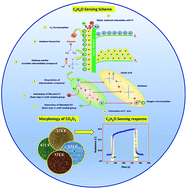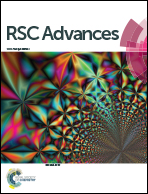Development of an acetone sensor using nanostructured Co3O4 thin films for exhaled breath analysis†
Abstract
In recent times, the development of breath sensors for the detection of Diabetic Keto-Acidosis (DKA) has been gaining prominent importance in the field of health care and advanced diagnostics. Acetone is one of the prominent biomarkers in the exhaled breath of persons affected by DKA. In this background, nanostructured cobalt oxide sensing elements were fabricated using a spray pyrolysis technique at different deposition temperatures (473 to 773 K in steps of 100 K) towards the fabrication of an acetone sensor. The influence of deposition temperature on the various properties of the nanostructured cobalt oxide thin films was investigated. Formation of cubic spinel phase cobalt oxide was confirmed from the structural analysis. The shifting of plane orientation from (3 1 1) to (2 2 0) at 773 K deposition temperature revealed the migration of cobalt atoms to the highly favorable energy positions. Further, the downshifted peak absorption wavelength and upshifted PL profile at higher deposition temperature confirmed the migration of cobalt ions. The sensor fabricated at higher deposition temperature (773 K) showed a sensing response of 235 at room temperature towards 50 ppm of acetone. Also, the fabricated sensor showed a lower detection limit (LOD) of 1 ppm with the response–recovery times of 6 and 4 s, respectively. The LOD reported here is lower than the minimum threshold level (1.71 ppm) signifying the presence of DKA.



 Please wait while we load your content...
Please wait while we load your content...